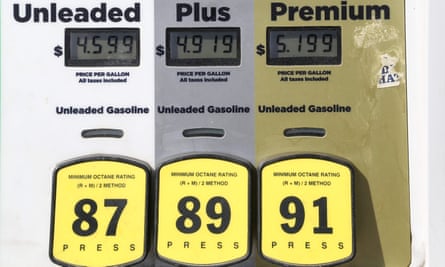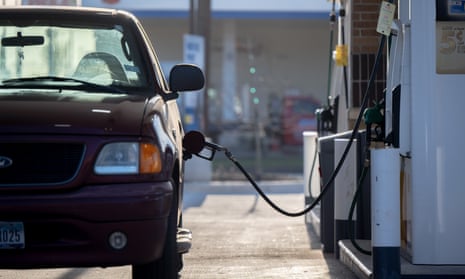Gasoline prices at the pump have surged, reaching a US national average of $4.34 on 21 March, and remain more than 70% greater than at this time last year. At the same time, global supplies of oil have actually increased, including from Russia, even amid the war in Ukraine.
So if high prices are not being driven by scarcity, what’s going on?
Experts are warning that little-publicized energy traders, most of whom work for the world’s largest oil companies, banks and privately held trading houses, are partly to blame.
The amount of trades – and the profits associated with them – have been skyrocketing, reaching record highs in 2021 and 2022. This inadequately regulated activity is hitting Americans’ pockets and represents a “market emergency”, according to Michael Greenberger, a former US government trading regulator.
“My instinct tells me that a very careful analysis of this market would show that the price is not reflective of supply chain problems, that there’s just too much leeway for the big banks and the big producers to manipulate if no one is looking and watching what they’re doing,” says Greenberger, the former division director of the Commodity Futures Trading Commission (CFTC), the main regulator of US energy markets.
“Nobody with power is looking at what they’re doing,” he says. “There’s no cop on the beat.”
Veteran oil analyst Philip K Verleger has warned that supply and demand “fundamentals have been rendered almost irrelevant” for oil prices, a key determinant of the price of gasoline at the pump.
He has pointed to a dramatic rise in speculation driven by artificial intelligence rapidly buying and selling massive energy bets based on minor or even nonexistent changes to real-world supplies. “Under these circumstances, a change in [supply and demand] fundamentals that might have moved prices by 50¢ or $1” will cause a change of as much as $10 a barrel of oil, he has written.
Overall, global oil production is nearly 5m more barrels a day greater in 2022 than in 2021, yet US politicians on both sides of the aisle have called for even more drilling. Oil exports from Russia into the global market have not been slowed by either the war or sanctions. Instead, they’re rising and are expected to end April higher than at any time since before the Covid pandemic, according to research firm Kpler.
“Crude is getting loaded on vessels and getting shipped. Which I think is the story right now,” Reid L’Anson, senior commodity economist at Kpler, told The Guardian.
There are certainly other factors putting upward pressure on prices, including fears that Russian supply could decline in the future. But the price of oil, natural gas, and other vital fossil fuel commodities are today primarily set by energy traders, whose actions are stoking rising prices and volatility.
Little physical oil actually changes hands with such trades, which take place on two main exchanges in the US, CME Group and the Intercontinental Exchange. Instead the trade is in futures contracts, a commitment to purchase a set amount of oil in the future for a price agreed in the present. But because the virtual trading has come to dwarf the physical trade, it now determines the price of oil.
Greenberger estimates that “something like 13 times the physical amount of oil is traded” via these purely financial contracts. And commercial trades – those based on the actual use of oil – have been pushed out, he says, replaced almost entirely by speculators looking to make a quick buck, which is in turn increasing excessive speculation and volatility.
According to data provided to the Guardian by CME Group, the amount of crude oil futures contracts traded daily on its platform rose in 2022 over 2021, and is nearly double that of a decade ago.
Rising prices and volatility have been on display since the day before Russian troops went to war against Ukraine, when the price of a barrel of oil was $90. Since the invasion, despite no change in supply, it has vaulted to a $124, fallen to $95, shot back up to $114, before sliding down to $103 a barrel today – over 60% higher than the price one year ago.

All the major oil companies, leading US banks, and lesser known private trading houses led by Vitol, Trafigura, Mercuria, and Glencore, are involved in speculative energy trading. Some have even been found guilty of illegal trading over the years. But determining their exact level of involvement is not easy, as there are few reporting requirements allowing the public into this largely opaque world.
In a 2020 earnings call with analysts, Shell CEO Ben van Beurden called Shell’s trading “core to the success of our company, it actually makes the magic in many cases”. Shell typically earns as much as $4bn annually from this trading.
“We’re seeing just massive volatility, in terms of trading activity, in terms of pricing, where you’ve got big bounces between prices, and so something is wrong,” says Tyson Slocum, director of Public Citizen’s Energy Program, a non-profit consumer advocacy organization. Slocum, who also serves on the Energy and Environmental Markets Advisory Committee to the CFTC, calls for greater regulation and transparency into a broken system where “speculators are allowed to reign free”.
The CFTC itself was weakened by Trump and crippled by vacancies under Biden, who left the majority of commission seats empty until late last month.
Slocum argues that the federal government has ceded too much authority to the futures exchanges. With profits based on volume of trades, they have little incentive to reign in traders, including excessive speculation, he alleges.
Asked to respond to these allegations, both CME Group and Intercontinental Exchange declined to comment.
There are signs that policymakers are starting to take note. Democratic senators Maria Cantwell and Amy Klobuchar led a commerce committee hearing earlier this month on potential manipulation in petroleum markets. Congressman Ro Khanna told the Guardian that he supports reforms to curb excessive speculation and step up enforcement with an ultimate goal of shifting to renewable energy.
Tyson Slocum agrees. Constant volatility and rising oil and natural gas prices at the hands of energy traders bring vast profits for a few, but hardship for most. It’s “a wake up call that we need to aggressively get off of fossil fuels”, he says. “What’s going on in the [futures] markets is actually not constructive or useful for a clean energy transition.”
